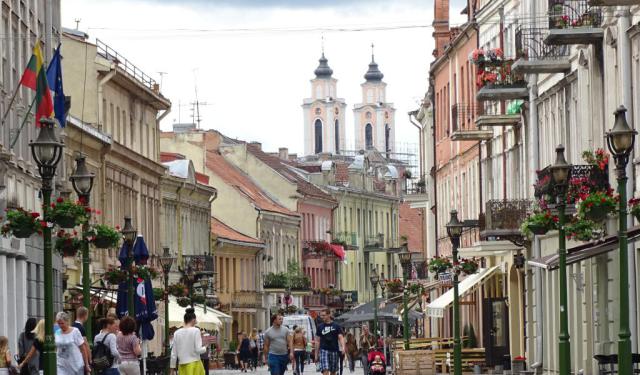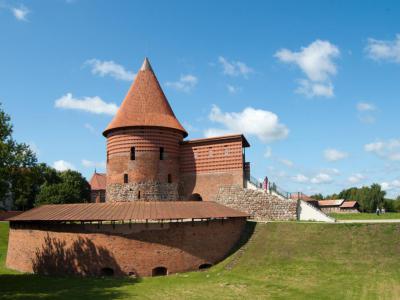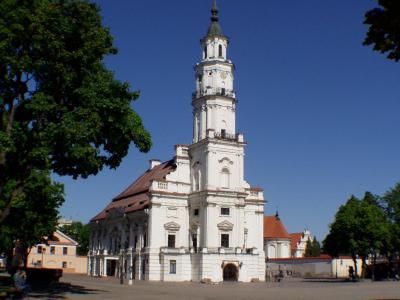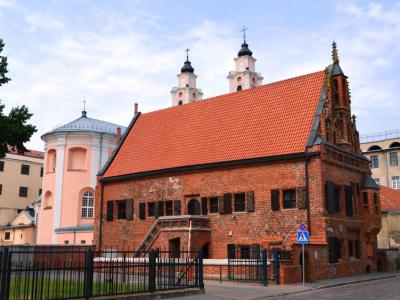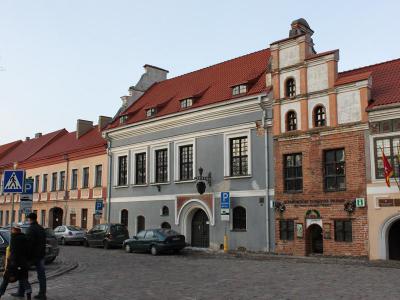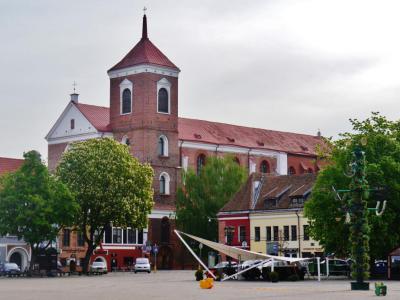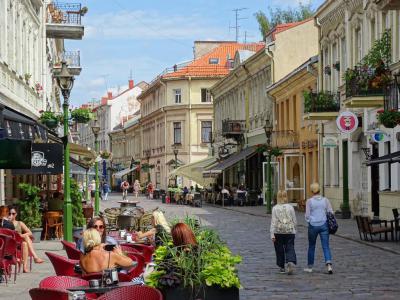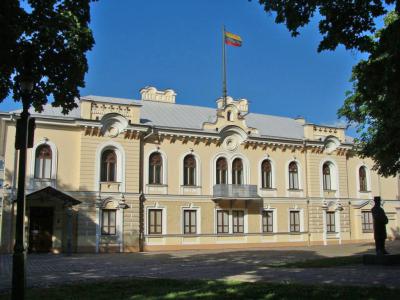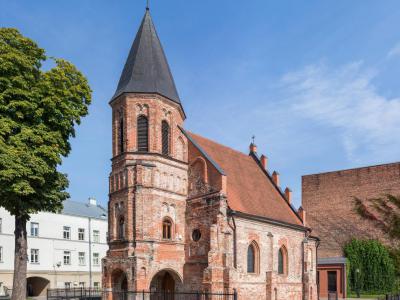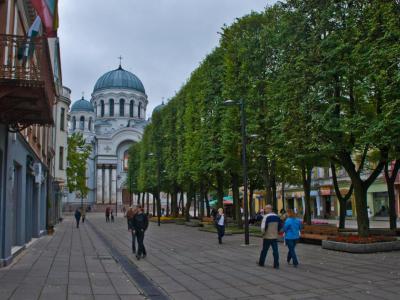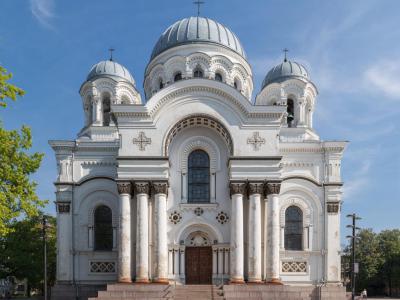Kaunas Introduction Walking Tour (Self Guided), Kaunas
The city of Kaunas, situated at the confluence of the Nemunas and Neris rivers in the south-central part of Lithuania, traces its history back to the 10th century AD.
A legend claims, though, that Kaunas was established in ancient times by the Romans led by a patrician named Palemon, who fled Rome out of fear of the mad Emperor Nero. After Palemon's death, his sons – Barcus, Kunas, and Sperus – divided his land. Kunas got the land where Kaunas now stands. He built a fortress there and the city that grew around it was named after him.
Historical records suggest, however, that the Kaunas Castle was erected in the 13th century as a safeguard against the Teutonic Order. The city's economic zenith occurred in the late 16th and early 17th centuries, marked by extensive brick masonry construction.
Despite periods of strife, including Russian and Swedish occupations, bubonic plague, and fires, Kaunas persevered. In 1795, it fell under Russian rule following the final partition of the Polish–Lithuanian state. During the French invasion of Russia in 1812, the city suffered immense destruction.
Kaunas played a pivotal role in Lithuania's history, serving as the country's capital during the 20th-century interwar period. A vibrant cultural scene, Art Deco architecture, and multiple cafes emerged in those years, earning the city its moniker "Little Paris". This era also witnessed economic prosperity and industrial growth in Kaunas.
The 1940 Soviet occupation and subsequent Nazi occupation during World War II brought tumultuous times to the city. However, post-war Kaunas emerged as Lithuania's primary industrial center.
In recent years, Kaunas has become easily accessible to foreign tourists, thanks to improved transport links with Western Europe.
The Town Hall, an architectural gem from the Renaissance era, graces Kaunas's central square and is a striking representation of its cultural heritage. Nearby, the House of Thunder (Perkūnas) showcases intricate Gothic architecture and serves as a museum that unveils the city's past.
The Kaunas Cathedral Basilica, an exquisite example of Baroque architecture, is a spiritual and cultural centerpiece of the city. At the same time, Freedom Avenue (Laisvės Aleja), the main artery of Kaunas, bustling with shops, cafes, and a lively atmosphere, perfectly embodies the city's spirit of freedom and progress.
Now, with a glimpse into the historical and cultural riches of Kaunas, we invite you to embark on this self-guided journey and explore the enchanting city in more detail. Come, immerse yourself in its stories, wander its picturesque streets, and discover the magic of this Lithuanian gem.
A legend claims, though, that Kaunas was established in ancient times by the Romans led by a patrician named Palemon, who fled Rome out of fear of the mad Emperor Nero. After Palemon's death, his sons – Barcus, Kunas, and Sperus – divided his land. Kunas got the land where Kaunas now stands. He built a fortress there and the city that grew around it was named after him.
Historical records suggest, however, that the Kaunas Castle was erected in the 13th century as a safeguard against the Teutonic Order. The city's economic zenith occurred in the late 16th and early 17th centuries, marked by extensive brick masonry construction.
Despite periods of strife, including Russian and Swedish occupations, bubonic plague, and fires, Kaunas persevered. In 1795, it fell under Russian rule following the final partition of the Polish–Lithuanian state. During the French invasion of Russia in 1812, the city suffered immense destruction.
Kaunas played a pivotal role in Lithuania's history, serving as the country's capital during the 20th-century interwar period. A vibrant cultural scene, Art Deco architecture, and multiple cafes emerged in those years, earning the city its moniker "Little Paris". This era also witnessed economic prosperity and industrial growth in Kaunas.
The 1940 Soviet occupation and subsequent Nazi occupation during World War II brought tumultuous times to the city. However, post-war Kaunas emerged as Lithuania's primary industrial center.
In recent years, Kaunas has become easily accessible to foreign tourists, thanks to improved transport links with Western Europe.
The Town Hall, an architectural gem from the Renaissance era, graces Kaunas's central square and is a striking representation of its cultural heritage. Nearby, the House of Thunder (Perkūnas) showcases intricate Gothic architecture and serves as a museum that unveils the city's past.
The Kaunas Cathedral Basilica, an exquisite example of Baroque architecture, is a spiritual and cultural centerpiece of the city. At the same time, Freedom Avenue (Laisvės Aleja), the main artery of Kaunas, bustling with shops, cafes, and a lively atmosphere, perfectly embodies the city's spirit of freedom and progress.
Now, with a glimpse into the historical and cultural riches of Kaunas, we invite you to embark on this self-guided journey and explore the enchanting city in more detail. Come, immerse yourself in its stories, wander its picturesque streets, and discover the magic of this Lithuanian gem.
How it works: Download the app "GPSmyCity: Walks in 1K+ Cities" from Apple App Store or Google Play Store to your mobile phone or tablet. The app turns your mobile device into a personal tour guide and its built-in GPS navigation functions guide you from one tour stop to next. The app works offline, so no data plan is needed when traveling abroad.
Kaunas Introduction Walking Tour Map
Guide Name: Kaunas Introduction Walking Tour
Guide Location: Lithuania » Kaunas (See other walking tours in Kaunas)
Guide Type: Self-guided Walking Tour (Sightseeing)
# of Attractions: 10
Tour Duration: 2 Hour(s)
Travel Distance: 3.8 Km or 2.4 Miles
Author: DanaOffice
Sight(s) Featured in This Guide:
Guide Location: Lithuania » Kaunas (See other walking tours in Kaunas)
Guide Type: Self-guided Walking Tour (Sightseeing)
# of Attractions: 10
Tour Duration: 2 Hour(s)
Travel Distance: 3.8 Km or 2.4 Miles
Author: DanaOffice
Sight(s) Featured in This Guide:
- Kaunas Castle
- Town Hall
- House of Perkūnas (House of Thunder)
- Museum of the History of Lithuanian Medicine and Pharmacy
- Kaunas Cathedral Basilica
- Vilniaus Gatve (Vilniaus Street)
- Historical Presidential Palace
- Church of St. Gertrude
- Laisves Aleja (Freedom Avenue)
- Church of St. Michael the Archangel
1) Kaunas Castle (must see)
The centuries-old Kaunas Castle is a significant historical and architectural landmark, offering visitors a glimpse into Lithuania's medieval past and its strategic importance. Kaunas Castle holds a central place in Lithuanian history, dating back to the 14th century. The castle is situated on a picturesque hill overlooking the confluence of two rivers, providing panoramic views of the surrounding landscape. The scenic location makes it a popular spot for photography and leisurely walks.
The castle features a mix of architectural styles, including Gothic, Renaissance, and Baroque elements. Its architecture has evolved over the centuries due to numerous renovations and reconstructions. Originally built as a wooden fortress in the 13th century, Kaunas Castle was later rebuilt using brick and stone to serve as a formidable defensive structure. It played a crucial role in protecting the city and its residents from external threats. The castle's architecture includes elements such as thick defensive walls, towers, a central courtyard, and a drawbridge, all of which contribute to its medieval charm. The castle's strategic location on the confluence of the Nemunas and Neris rivers adds to its allure.
At different points in history, the castle served as a residence for Lithuanian dukes and other nobility. It was also used for important state functions, including the signing of treaties and the hosting of foreign dignitaries.
Today, Kaunas Castle is home to a museum that showcases its history, archaeological discoveries, and the medieval life of the region. Visitors can explore the museum's exhibits to gain a deeper understanding of the castle's historical context.
Kaunas Castle often hosts cultural events, performances, and historical reenactments that transport visitors back in time to experience the medieval period. These events add to the castle's cultural vibrancy.
The castle features a mix of architectural styles, including Gothic, Renaissance, and Baroque elements. Its architecture has evolved over the centuries due to numerous renovations and reconstructions. Originally built as a wooden fortress in the 13th century, Kaunas Castle was later rebuilt using brick and stone to serve as a formidable defensive structure. It played a crucial role in protecting the city and its residents from external threats. The castle's architecture includes elements such as thick defensive walls, towers, a central courtyard, and a drawbridge, all of which contribute to its medieval charm. The castle's strategic location on the confluence of the Nemunas and Neris rivers adds to its allure.
At different points in history, the castle served as a residence for Lithuanian dukes and other nobility. It was also used for important state functions, including the signing of treaties and the hosting of foreign dignitaries.
Today, Kaunas Castle is home to a museum that showcases its history, archaeological discoveries, and the medieval life of the region. Visitors can explore the museum's exhibits to gain a deeper understanding of the castle's historical context.
Kaunas Castle often hosts cultural events, performances, and historical reenactments that transport visitors back in time to experience the medieval period. These events add to the castle's cultural vibrancy.
2) Town Hall
The Town Hall is one of Kaunas' most historically significant landmarks, with its origins dating back to the 16th century. It has played a central role in the city's administrative and cultural life for centuries.
The Town Hall showcases an exquisite Renaissance architectural style, characterized by its ornate facades, symmetrical design, and decorative elements. Its impressive clock tower is a notable feature that rises high above the city skyline.
The clock tower of the Town Hall is a prominent and iconic symbol of Kaunas. It houses a mechanical clock that has been meticulously maintained and is still in operation today. The chimes of the clock are a familiar sound in the city.
Throughout its history, the Town Hall has served various functions, including housing the city's administrative offices, serving as a meeting place for local officials, and hosting cultural events and exhibitions.
The Town Hall is not just an architectural marvel; it's also a venue for cultural events, exhibitions, and public gatherings. Its central location and elegant interior make it an ideal setting for concerts, art exhibitions, and other cultural activities.
The Town Hall showcases an exquisite Renaissance architectural style, characterized by its ornate facades, symmetrical design, and decorative elements. Its impressive clock tower is a notable feature that rises high above the city skyline.
The clock tower of the Town Hall is a prominent and iconic symbol of Kaunas. It houses a mechanical clock that has been meticulously maintained and is still in operation today. The chimes of the clock are a familiar sound in the city.
Throughout its history, the Town Hall has served various functions, including housing the city's administrative offices, serving as a meeting place for local officials, and hosting cultural events and exhibitions.
The Town Hall is not just an architectural marvel; it's also a venue for cultural events, exhibitions, and public gatherings. Its central location and elegant interior make it an ideal setting for concerts, art exhibitions, and other cultural activities.
3) House of Perkūnas (House of Thunder)
The House of Perkūnas is a medieval structure that dates back to the 15th century. It stands as a symbol of Kaunas' rich history and architectural heritage. This Gothic building features a striking design with intricate brickwork, pointed arches, and decorative elements that are characteristic of the Gothic style. It is renowned for its historical and architectural value.
In English, the "House of Perkūnas" would be translated as the "House of Thunder" or "Perkūnas House," reflecting its association with the Lithuanian god of thunder.
Throughout its history, the House of Perkūnas has served various purposes, including as a merchant's residence, an inn, and a tavern. It was a bustling center for commerce and social gatherings during the medieval period. The building has undergone extensive preservation and restoration efforts to maintain its historical and architectural significance. These efforts have helped ensure that it continues to stand as a testament to Kaunas' past.
Today, the House of Perkūnas serves as a cultural venue, hosting art exhibitions, concerts, and cultural events. It has become an important cultural hub in Kaunas, contributing to the city's vibrant arts scene.
In English, the "House of Perkūnas" would be translated as the "House of Thunder" or "Perkūnas House," reflecting its association with the Lithuanian god of thunder.
Throughout its history, the House of Perkūnas has served various purposes, including as a merchant's residence, an inn, and a tavern. It was a bustling center for commerce and social gatherings during the medieval period. The building has undergone extensive preservation and restoration efforts to maintain its historical and architectural significance. These efforts have helped ensure that it continues to stand as a testament to Kaunas' past.
Today, the House of Perkūnas serves as a cultural venue, hosting art exhibitions, concerts, and cultural events. It has become an important cultural hub in Kaunas, contributing to the city's vibrant arts scene.
4) Museum of the History of Lithuanian Medicine and Pharmacy
The Museum of the History of Lithuanian Medicine and Pharmacy is a unique and educational museum. The museum is dedicated to preserving and sharing the rich history of medicine and pharmacy in Lithuania. It highlights the contributions of Lithuanian medical professionals and the development of healthcare practices over the centuries.
The museum houses an extensive collection of artifacts, documents, and exhibits related to the field of medicine and pharmacy. The collection includes medical instruments, laboratory equipment, pharmaceutical tools, and historical texts.
Visitors can explore educational exhibits that chronicle the progress of medicine and pharmacy in Lithuania from ancient times to the present day. The displays offer insights into the evolution of medical practices, pharmacology, and healthcare in the region. The museum places its exhibits in a historical context, allowing visitors to understand the social, cultural, and scientific factors that influenced the development of medicine and pharmacy in Lithuania.
The museum pays homage to Lithuanian medical pioneers and innovators who have made significant contributions to the field. Their life stories and achievements are highlighted throughout the exhibits. A substantial part of the museum's collection is dedicated to the history of pharmaceutical sciences in Lithuania. Visitors can learn about the development of pharmacies, the production of medicines, and the role of pharmacists in society.
The museum houses an extensive collection of artifacts, documents, and exhibits related to the field of medicine and pharmacy. The collection includes medical instruments, laboratory equipment, pharmaceutical tools, and historical texts.
Visitors can explore educational exhibits that chronicle the progress of medicine and pharmacy in Lithuania from ancient times to the present day. The displays offer insights into the evolution of medical practices, pharmacology, and healthcare in the region. The museum places its exhibits in a historical context, allowing visitors to understand the social, cultural, and scientific factors that influenced the development of medicine and pharmacy in Lithuania.
The museum pays homage to Lithuanian medical pioneers and innovators who have made significant contributions to the field. Their life stories and achievements are highlighted throughout the exhibits. A substantial part of the museum's collection is dedicated to the history of pharmaceutical sciences in Lithuania. Visitors can learn about the development of pharmacies, the production of medicines, and the role of pharmacists in society.
5) Kaunas Cathedral Basilica
The Kaunas Cathedral Basilica is one of the oldest and most historically significant religious buildings in Lithuania. It has witnessed centuries of the country's history and played a vital role in the development of Christianity in the region. It is dedicated to the apostles Saint Peter and Saint Paul. In 1926, the Kaunas Cathedral was elevated to the status of a basilica by Pope Pius XI in recognition of its historical and religious significance.
The cathedral boasts a magnificent Gothic and Baroque architectural style, with elements of Renaissance and Neoclassical design. Its facade is adorned with intricate sculptures, decorative reliefs, and elegant columns.
Inside the Kaunas Cathedral Basilica, visitors can admire a stunning interior filled with Baroque and Neoclassical elements. The nave is adorned with ornate altars, frescoes, and a magnificent organ.
The cathedral has hosted various historical events, including the consecration of bishops, royal weddings, and important religious ceremonies. It remains a symbol of Lithuania's faith and heritage. It often hosts classical music concerts, choral performances, and art exhibitions, enriching the cultural life of Kaunas.
In the cathedral's courtyard, there is a prominent Freedom Monument (Laisvės Angelas), which commemorates those who fought for Lithuanian independence. The monument serves as a focal point for national celebrations and gatherings.
The cathedral boasts a magnificent Gothic and Baroque architectural style, with elements of Renaissance and Neoclassical design. Its facade is adorned with intricate sculptures, decorative reliefs, and elegant columns.
Inside the Kaunas Cathedral Basilica, visitors can admire a stunning interior filled with Baroque and Neoclassical elements. The nave is adorned with ornate altars, frescoes, and a magnificent organ.
The cathedral has hosted various historical events, including the consecration of bishops, royal weddings, and important religious ceremonies. It remains a symbol of Lithuania's faith and heritage. It often hosts classical music concerts, choral performances, and art exhibitions, enriching the cultural life of Kaunas.
In the cathedral's courtyard, there is a prominent Freedom Monument (Laisvės Angelas), which commemorates those who fought for Lithuanian independence. The monument serves as a focal point for national celebrations and gatherings.
6) Vilniaus Gatve (Vilniaus Street)
Vilnius Street is one of the oldest streets in Kaunas, with a history dating back several centuries. It has witnessed the city's growth and development over the years and retains a strong connection to its past. The street showcases a diverse range of architectural styles, reflecting Kaunas' history and evolution. You can find a mix of architectural influences, including Gothic, Baroque, Neoclassical, and Art Nouveau, among others.
Vilnius Street is predominantly a pedestrian-friendly street, making it ideal for leisurely strolls and exploring the surroundings. The street is lined with cafes, shops, boutiques, and restaurants, creating a lively and inviting atmosphere. You can explore local boutiques, find unique gifts, sample Lithuanian cuisine, or savor international dishes in the many restaurants and cafes.
Vilnius Street is also home to several cultural institutions, including art galleries, museums, and theaters. This cultural richness adds to the street's vibrancy and makes it an ideal destination for those interested in the arts. The street hosts various festivals, parades, and cultural events throughout the year. too.
Vilnius Street often attracts street performers, musicians, and artists who entertain visitors with their talents. These impromptu performances add to the lively ambiance of the street.
As the day transitions into evening, Vilniaus gatvė comes alive with a vibrant nightlife scene. It's a popular destination for those looking to enjoy a night out in Kaunas, with many bars and clubs open late.
Vilnius Street is predominantly a pedestrian-friendly street, making it ideal for leisurely strolls and exploring the surroundings. The street is lined with cafes, shops, boutiques, and restaurants, creating a lively and inviting atmosphere. You can explore local boutiques, find unique gifts, sample Lithuanian cuisine, or savor international dishes in the many restaurants and cafes.
Vilnius Street is also home to several cultural institutions, including art galleries, museums, and theaters. This cultural richness adds to the street's vibrancy and makes it an ideal destination for those interested in the arts. The street hosts various festivals, parades, and cultural events throughout the year. too.
Vilnius Street often attracts street performers, musicians, and artists who entertain visitors with their talents. These impromptu performances add to the lively ambiance of the street.
As the day transitions into evening, Vilniaus gatvė comes alive with a vibrant nightlife scene. It's a popular destination for those looking to enjoy a night out in Kaunas, with many bars and clubs open late.
7) Historical Presidential Palace
The Historical Presidential Palace is one of the most historically significant buildings in Lithuania. It served as the official residence of the Lithuanian President during the interwar period (1920-1940), when Kaunas was the temporary capital of the country.
The palace is a beautiful example of Neoclassical architecture, characterized by its grandeur, symmetry, and classical elements. The building's facade features imposing columns, decorative reliefs, and a pediment that adds to its stately appearance.
During its time as the Presidential Palace, the building hosted numerous important state events, diplomatic meetings, and official receptions. It was at this location that Lithuanian presidents received foreign dignitaries and conducted state affairs.
The palace has a strong connection to Lithuania's struggle for independence. It served as the backdrop for important moments in the nation's history, including the signing of the country's first constitution and the declaration of Lithuania's sovereignty.
Today, the Historical Presidential Palace serves as a museum that commemorates the interwar period and the presidency of Lithuania during that time. Visitors can explore various exhibits, artifacts, and documents that shed light on the political, cultural, and social life of the era.
The palace is surrounded by well-maintained gardens and green spaces, which add to its charm. The gardens are a peaceful place to stroll and admire the architecture while taking in the historical ambiance of the surroundings.
The Historical Presidential Palace is considered a national symbol of Lithuania's quest for independence and its commitment to preserving its cultural and historical heritage.
The palace is a beautiful example of Neoclassical architecture, characterized by its grandeur, symmetry, and classical elements. The building's facade features imposing columns, decorative reliefs, and a pediment that adds to its stately appearance.
During its time as the Presidential Palace, the building hosted numerous important state events, diplomatic meetings, and official receptions. It was at this location that Lithuanian presidents received foreign dignitaries and conducted state affairs.
The palace has a strong connection to Lithuania's struggle for independence. It served as the backdrop for important moments in the nation's history, including the signing of the country's first constitution and the declaration of Lithuania's sovereignty.
Today, the Historical Presidential Palace serves as a museum that commemorates the interwar period and the presidency of Lithuania during that time. Visitors can explore various exhibits, artifacts, and documents that shed light on the political, cultural, and social life of the era.
The palace is surrounded by well-maintained gardens and green spaces, which add to its charm. The gardens are a peaceful place to stroll and admire the architecture while taking in the historical ambiance of the surroundings.
The Historical Presidential Palace is considered a national symbol of Lithuania's quest for independence and its commitment to preserving its cultural and historical heritage.
8) Church of St. Gertrude
Church of Saint Gertrude is one of the oldest Brick Gothic churches and buildings of Gothic architecture in Lithuania. The Church is dedicated to Saint Gertrude of Nivelles, a 7th-century abbess and patron saint of travelers. It has served as a place of worship, prayer, and spiritual reflection for the faithful of Kaunas for generations.
The church is a prime example of Gothic Revival architecture, characterized by its pointed arches, ornate details, and vertical lines. The design draws inspiration from medieval Gothic churches, creating a sense of timeless beauty. Inside the church, visitors can admire its graceful and tranquil interior. The nave is adorned with decorative altars, religious artworks, and stained glass windows that add to its spiritual ambiance.
In addition to its religious importance, the Church of Saint Gertrude is also recognized as a cultural landmark in Kaunas. It often hosts concerts, choral performances, and art exhibitions, contributing to the city's vibrant cultural scene.
The church is a prime example of Gothic Revival architecture, characterized by its pointed arches, ornate details, and vertical lines. The design draws inspiration from medieval Gothic churches, creating a sense of timeless beauty. Inside the church, visitors can admire its graceful and tranquil interior. The nave is adorned with decorative altars, religious artworks, and stained glass windows that add to its spiritual ambiance.
In addition to its religious importance, the Church of Saint Gertrude is also recognized as a cultural landmark in Kaunas. It often hosts concerts, choral performances, and art exhibitions, contributing to the city's vibrant cultural scene.
9) Laisves Aleja (Freedom Avenue) (must see)
One of the most prominent and iconic streets in Kaunas, Freedom Avenue is steeped in history and has witnessed significant events over the years. It played a central role in Lithuania's struggle for independence and has been a focal point for political and cultural activities in the city.
One of the distinctive features of Freedom Avenue is its wide pedestrian-friendly boulevard. The avenue is lined with trees, benches, and sculptures, creating a welcoming and relaxed atmosphere that invites both residents and tourists to stroll and enjoy the surroundings.
The avenue showcases a diverse range of architectural styles, reflecting the city's history and evolution. You can find a mix of neoclassical, art deco, and modernist buildings along Freedom Avenue, making it a fascinating destination for architectural enthusiasts.
Freedom Avenue is a bustling hub for shopping and dining. Along the avenue, you'll find an array of shops, boutiques, cafes, restaurants, and bars. It's an ideal place to explore local fashion, find unique gifts, or enjoy Lithuanian cuisine and international dishes.
The avenue is home to several cultural institutions, including theaters, art galleries, and cinemas. The Maironis Lithuanian Literature Museum and the Kaunas State Drama Theatre are notable cultural landmarks that enrich the cultural scene of the area.
The lively atmosphere of Freedom Avenue often attracts street performers and musicians. Visitors can enjoy impromptu musical performances, art exhibitions, and other creative expressions while wandering the avenue.
At the heart of Freedom Avenue stands the Freedom Monument (Laisvės Atgavimo Skveras), a symbol of Lithuania's independence and national pride. The monument commemorates those who fought for Lithuania's freedom and is a focal point for various national celebrations and gatherings.
One of the distinctive features of Freedom Avenue is its wide pedestrian-friendly boulevard. The avenue is lined with trees, benches, and sculptures, creating a welcoming and relaxed atmosphere that invites both residents and tourists to stroll and enjoy the surroundings.
The avenue showcases a diverse range of architectural styles, reflecting the city's history and evolution. You can find a mix of neoclassical, art deco, and modernist buildings along Freedom Avenue, making it a fascinating destination for architectural enthusiasts.
Freedom Avenue is a bustling hub for shopping and dining. Along the avenue, you'll find an array of shops, boutiques, cafes, restaurants, and bars. It's an ideal place to explore local fashion, find unique gifts, or enjoy Lithuanian cuisine and international dishes.
The avenue is home to several cultural institutions, including theaters, art galleries, and cinemas. The Maironis Lithuanian Literature Museum and the Kaunas State Drama Theatre are notable cultural landmarks that enrich the cultural scene of the area.
The lively atmosphere of Freedom Avenue often attracts street performers and musicians. Visitors can enjoy impromptu musical performances, art exhibitions, and other creative expressions while wandering the avenue.
At the heart of Freedom Avenue stands the Freedom Monument (Laisvės Atgavimo Skveras), a symbol of Lithuania's independence and national pride. The monument commemorates those who fought for Lithuania's freedom and is a focal point for various national celebrations and gatherings.
10) Church of St. Michael the Archangel
The Church of Saint Michael the Archangel is one of the oldest churches in Kaunas, with a history dating back to the 14th century. It has witnessed centuries of Lithuania's history and played a crucial role in the city's spiritual and cultural life.
The church's architecture is a fascinating blend of different styles due to multiple renovations and reconstructions over the centuries. Its current appearance is primarily Neo-Gothic, characterized by pointed arches, intricate stonework, and soaring spires. The church's facade features intricate details and decorative elements that make it a captivating sight.
Inside the church, visitors can admire a stunning interior that combines Gothic, Baroque, and Renaissance elements. The altar and the pulpit are particularly notable for their intricate carvings and ornate decorations. The church's stained glass windows and vaulted ceilings add to its grandeur.
The Church of Saint Michael the Archangel is not only a place of worship but also a venue for various cultural events, including concerts, exhibitions, and religious ceremonies. Its acoustics make it an excellent setting for musical performances, and it often hosts classical concerts and choral recitals.
The church's architecture is a fascinating blend of different styles due to multiple renovations and reconstructions over the centuries. Its current appearance is primarily Neo-Gothic, characterized by pointed arches, intricate stonework, and soaring spires. The church's facade features intricate details and decorative elements that make it a captivating sight.
Inside the church, visitors can admire a stunning interior that combines Gothic, Baroque, and Renaissance elements. The altar and the pulpit are particularly notable for their intricate carvings and ornate decorations. The church's stained glass windows and vaulted ceilings add to its grandeur.
The Church of Saint Michael the Archangel is not only a place of worship but also a venue for various cultural events, including concerts, exhibitions, and religious ceremonies. Its acoustics make it an excellent setting for musical performances, and it often hosts classical concerts and choral recitals.
The Most Popular Cities
/ view all
